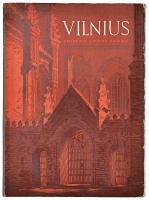
.jpg)

Giedrio Street
| Author: |
Samuel Rozin (1926–2006)  |
| Created: | 1957 |
| Material: | paper |
| Technique: | colour linocut |
| Dimensions: | 41 × 30 cm |
Series Vilnius, II, 1957.
Rozin’s series Vilnius reflects the artist’s training and the Leningrad tradition of graphic art: strong and realistic draughtsmanship, skilfully engraved in a complicated multi-colour linocut technique. He created a simultaneously grim, beautiful and dramatic picture of Vilnius, which makes us wonder about his viewpoint: whether it is the tense atmosphere of Stalin’s times, or the tragedy of the Holocaust and the memory of the murdered residents of Vilnius that hangs over the town. He chose standard sights in the Old Town for his pictures: the Cathedral, the Gates of Dawn, St Anne’s Church, courtyards, and narrow streets that had already been given new Soviet names. But all of his subjects are portrayed either in autumn or in winter, in the evening or at night, against the background of a dark and stormy sky, and dramatic clouds. It is a joyless city, and even the tower on Gediminas Hill, with the flag of Soviet Lithuania flying from it, exudes a grim late autumn mood. Having experienced the dismal Soviet reality, Rozin joined the 1970s wave of Jewish emigration, left for Israel in 1973, and settled in Tel Aviv. Like many others who left the Soviet ‘paradise’, his name was forgotten in Soviet Lithuania, and the series Vilnius disappeared from the public sphere and was removed from the collections of libraries. Today the series is a publishing rarity.
Text author Laima Laučkaitė
The new face of Vilnius. Under Sovietisation, the Jewish identity of Vilnius was forced into oblivion, and the image of the city as the Jerusalem of Lithuania disappeared from art. The Soviet authorities deliberately destroyed the Jewish heritage of Vilnius. Between 1955 and 1957, the ruins of the Great Synagogue of Vilnius that had survived the war were razed to the ground, although the synagogue could easily have been rebuilt. The Vilna Gaon Synagogue and other synagogues, as well as the Strashun Library, were also demolished.
In 1957, the painter Samuel Rozin published a series of ten colour linocuts called Vilnius (the number of copies is not known). The printmaker captured the most beautiful views of old Vilnius in separate prints, including Gediminas’ Castle, the Gates of Dawn, the Cathedral and its bell tower, and Giedrio Street (now Šv. Ignoto Street). The simple forms and the muted greyish-blue and tawny colours create an image of a rather gloomy and mysterious city, but its old spirit was already lost. This is the new face of Soviet Vilnius.
Text author Vilma Gradinskaitė
Source: Law firm Valiunas Ellex art album VILNIUS. TOPOPHILIA II (2015). Compiler and author Laima Laučkaitė, STORIES OF LITVAK ART (2023). Compiler and author Vilma GradinskaitėExpositions: “Vilnius. Topophilia. Views of Vilnius from the collection of the law firm Ellex Valiunas”, 5 October – 26 November 2017, National Gallery of Art, Vilnius (curator Laima Laučkaitė). "Kaunas–Vilnius: Moving Mountains", 7 April – 28 August 2022, MO Museum Vilnius. Curators and co-curators of the exhibition: Justina Juodišiūtė, Kotryna Lingienė, Ernestas Parulskis, Miglė Survilaitė, Rasa Žukienė.








.jpg)
.jpg)
.jpg)
.jpg)
.jpg)
.jpg)
.jpg)
.jpg)
.jpg)
.jpg)